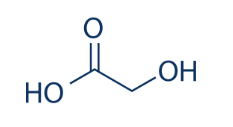Knowde Enhanced TDS
Identification & Functionality
- Cosmetic Ingredients Functions
- Technologies
- Product Families
- Molecular Structure

Features & Benefits
- Benefit Claims
- Labeling Claims
- Features
- Formaldehyde Free - We do not use this toxic chemical as the starting material for our process.
- Naturally Derived & Bio-based - Our starting feedstock is of plant based origin. We provide third party certification.
- Biome Friendly - Free of common contaminants which are harmful to the biodiversity of the skin, such as formaldehyde, our ingredients can be used in Biome Friendly formulations.
- Reduce Our Carbon Footprint - While many cosmetic ingredients are made from oil, ours starts off as carbon dioxide in the atmosphere, which helps to reduce the carbon footprint.
- Formaldehyde Free Glycolic Acid
Most of the ingredients we find in our cosmetics and personal care products are derived from crude oil. These products often contain residual chemical contaminants like formaldehyde that are harmful for our skin and for the billions of beneficial bacteria that grow on our skin and protect us. Wouldn't it be better if we didn't have to use ingredients made from crude oil?
I thought all glycolic acid is biobased?
The short answer is no. Glycolic acid is largely sourced from petroleum (oil)! Conventional glycolic acid is produced through a process known as carbonylation. The process begins with formaldehyde as a starting material. The manufacturing process leaves behind potentially harmful and measurable impurities like formaldehyde in the finished product. And, this is never mentioned on the ingredient list!
Is Purolic Acid™ really a biobased, drop-in replacement?
Yes, our fermentation is a simple, biological process that generates a high purity, potent glycolic acid drop-in replacement. The glycolic acid made by this process is a chemically identical molecule, but is free of the some of the contaminants found in the conventional manufacturing process. Our biobased glycolic starts of as CO2 from the atmosphere. By choosing a biobased glycolic acid we can reduce our carbon footprint. We estimate that our fermentation derived glycolic acid has a carbon footprint that is up to 35% lower.
Applications & Uses
- Markets
- Applications